Space & Physics
Chandrayaan-3: The moon may have had a fiery past
A magma ocean might’ve wrapped the ancient moon, suggests findings from India’s robotic lunar mission, Chandrayaan-3.

On 23rd August last year, India’s Chandrayaan-3 made history being the first to soft-land on the moon’s south polar region. The landing marked the end of the high-octane phase of the mission. But its next phase was a slow-burner.
Pragyan, the suitcase-sized rover, that hitched a ride to the moon aboard the lander, Vikram, rolled off a ramp onto the lunar surface. It traversed along the dusty lunar surface slowly, at a pace even a snail could beat. Handlers at the Indian Space Research Organization (ISRO) didn’t want the suitcase-sized rover to risk stumbling over a rock or near a ridge, and jeopardize the mission.
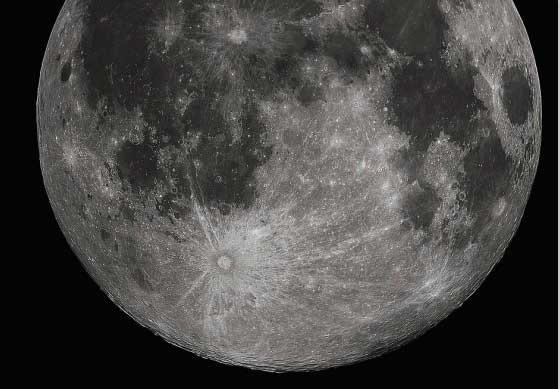
The whitish spots are material excavated from the moon’s interior.
Nevertheless, the rover had a busy schedule to stick to. It was to probe the lunar soil, and relay that scientific data back to earth. Pragyan covered 100 meters in two weeks, before it stopped to take a nap ahead of a long lunar night. At the time, the rover’s battery pack was fully charged, thanks to the on-board solar panels soaking up sunlight during the day.
But lunar weather is harsh, especially at the south pole, where Pragyan napped, temperatures can reach as low as -250 degrees centigrade during the night. Added to that, a lunar night lasts two weeks. ISRO deemed Pragyan had only a 1% chance to survive.
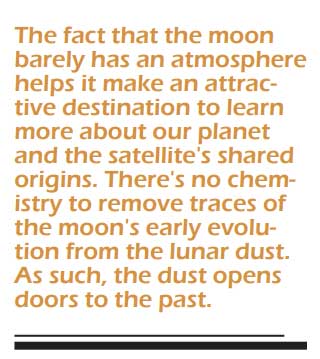
Later, the expected happened, when the rover went unresponsive to ISRO’s pings to wake up.
But ISRO said the rover achieved what it was tasked to do. It relayed data all along for two weeks, examining soil from some 23 locations around the mission’s landing point, Statio Shiv Shakti. As months passed by, a slew of discoveries were made. Sulphur was discovered at the south pole, early on while the mission was ongoing. And only a few months ago, Pragyan found evidence of past weathering activity at the south pole.
But since August this year, research teams from ISRO and the Physical Research Laboratory in Ahmedabad, India, reported Pragyan’s most important findings yet – one of which sheds light onto the moon’s origins.
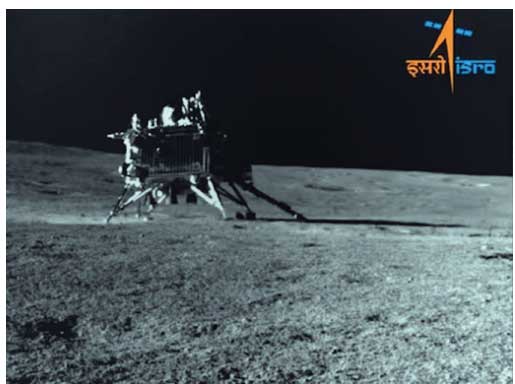
Chandrayaan-3’s Vikram lander, seen from the Pragyan rover’s camera
Moon and the Early Earth
Chandrayaan-3 had carried a radioactive passenger to the moon’s surface – curium-244.
The radioactive curium helps lase the surface: firing alpha particles (which are helium nuclei) at the dusty terrain. Some of these alpha particles bounce off the dust, whereas others evict electrons from the lunar soil, thereby producing x-ray emissions. Keeping watch is the Alpha Particle X-ray Spectrometer (APXS) on-board the Pragyan rover. In August, PRL scientists published findings in the journal, Nature, based on APXS data, reporting discovery of ferroan anorthosite.
It wasn’t the first ever detection per se of ferroan anorthosite. In fact, Apollo 11 had brought back anorthosite rocks to earth, where they were identified as such. That was in 1969, and Apollo sampled them from the equator. Successive missions by the Soviet Union and most recently China affirmed likewise from mid-latitude – equatorial regions as well. But Pragyan’s detection of the rock type was the first ever from the polar region.
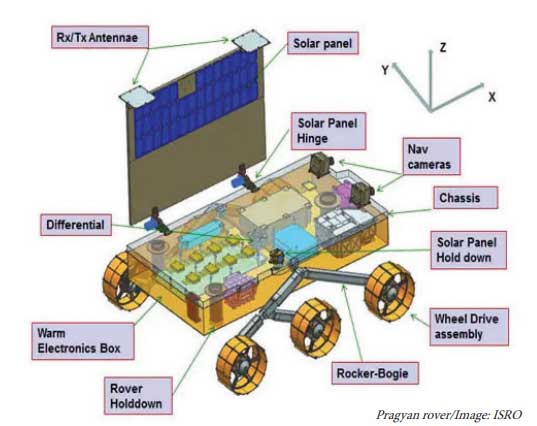
The Pragyan rover’s payload.
Anorthosites are common on earth. In fact, just a year after the Apollo 11 sampled the rock, scientists had evidence of the earth and the moon’s entangled history. The authors noted the similar composition between these rocks, that are geographically widespread. Furthermore, ferroan anorthosite is an igneous rock that forms on earth when hot lava produced in volcanic eruptions cools down.
And scientists had piled up evidence in support of a similar process that underwent on the moon. The anorthosite rocks on the moon are old, in fact, more than 4 billion years ago – a figure close to the earth’s inception with rest of the solar system – around 4.5 billion years. Scientific consensus has been that the moon was formed from remnants of a collision between the early earth and a rogue Mars-sized planetary body.

But the collision energy would have yielded a moon that was molten. A lava blanketing the surface – aka a global magma ocean. As this ocean cooled, minerals amongst which is plagioclase (a class of feldspar) crystallized and formed the anorthosite rocks on the moon. It’s commonly called the lunar magma ocean hypothesis.
When Pragyan treaded over the dusty lunar terrain, it didn’t register the anorthosite as a physical rock per se. Instead, it observed remnants of the rock, as fine powder.
Meteorites beat down rocks to fine powder, as they slam into the moon from space with regular impunity. On earth, the ground is saved by the presence of an atmosphere. But the moon virtually has no atmosphere. Nor does it have water to wear down the rocks. The surface is extremely hot during the lunar day – in fact, when Chandrayaan-3 landed on the moon, the surface temperature was some 50 degrees centigrade. Just a few months ago, Pragyan revealed possible signs of rock degradation from the rims of a crater.
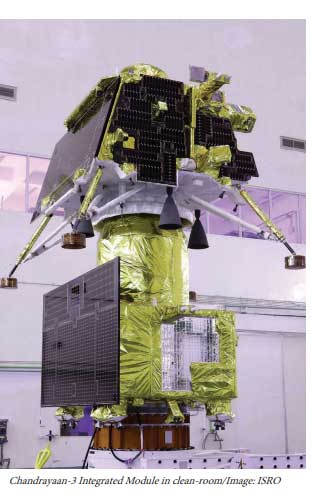
Moon dust opens doors to the past
The fact the moon doesn’t (and can’t) sustain an atmosphere helps it make an attractive destination to learn more about our planet and the satellite’s shared origins. There’s no chemistry to remove traces of the moon’s early evolution from the lunar dust. As such, the dust opens doors to the past.
Space explorations missions soft-landing on the surface study this dust – or sample and shuttle them to earth for scientists to study them in detail.
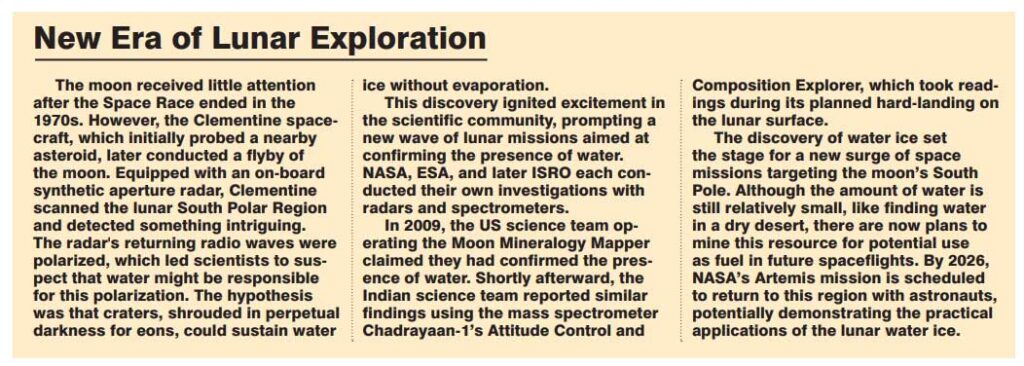
In fact, Pragyan revealed a crater that’s amongst the oldest ever discovered on the moon. The findings were published in the journal, Icarus, in September. Hidden in plain sight, the rover’s navigation camera, NavCam, spotted subtle stretch marks on the surface, that were confirmed later with the Chandrayaan-2 orbiter (which has been orbiting the moon since 2019). In fact, this crater was found buried under nearby craters, most notably the South Pole-Aitkin basin located 350 km away. The basin is the largest impact crater in the entire solar system (some 2,500 km wide and 8 km deep) touted to have formed millions of years ago.
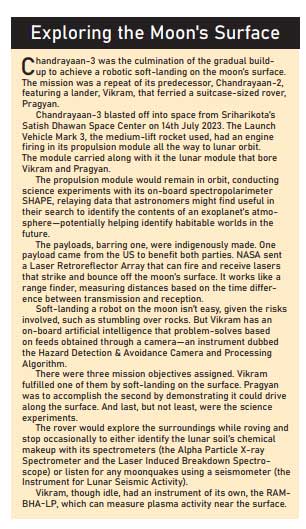
And this became subject to an earlier paper that PRL scientists authored, and was published in August. Pragyan identified material thought to have emerged from the moon’s interior. The APXS instrument picked up unusually high magnesium content in the vicinity. The authors speculate the meteorite that created the basin probably dug up magnesium from deep inside the moon’s upper mantle, and spewed them into Pragyan’s vicinity.
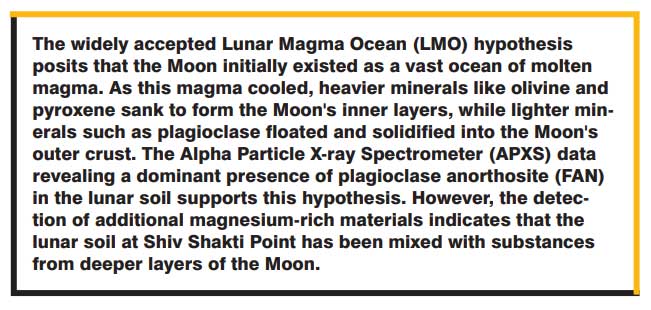
But some experts believe in an alternate explanation. They believe the magnesium might have come from surface rocks in the vicinity, and not from the upper mantle. In fact, the authors acknowledged this amongst other possible alternatives. Nonetheless, the Chandrayaan-3’s findings doesn’t dispute the lunar magma ocean hypothesis either, if not backing it outright. Saying that, the theory lives on to fight another day.
Space & Physics
Physicists Double Precision of Optical Atomic Clocks with New Laser Technique
MIT researchers develop a quantum-enhanced method that doubles the precision and stability of optical atomic clocks, paving the way for portable, ultra-accurate timekeeping.
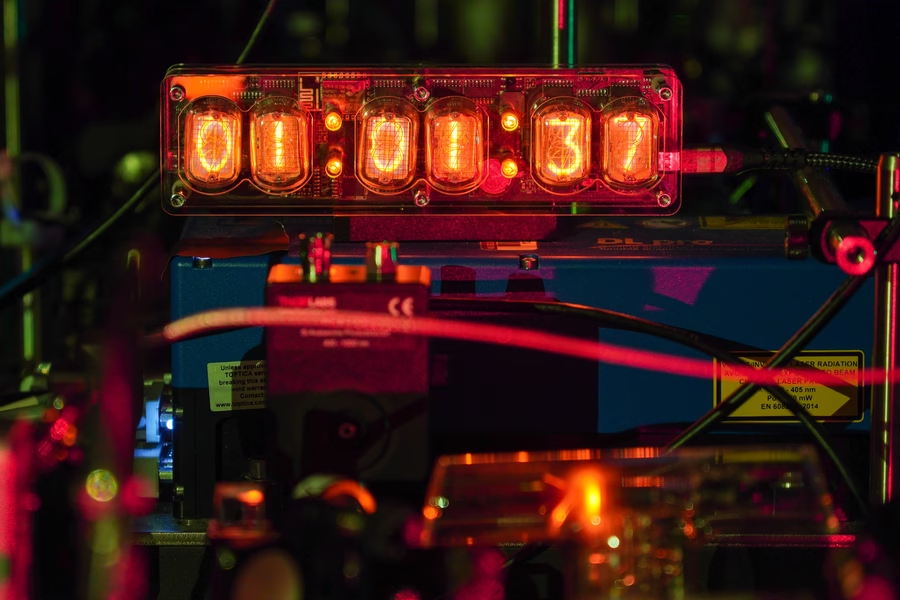
MIT physicists have unveiled a new technique that could significantly improve the precision and stability of next-generation optical atomic clocks, devices that underpin everything from mobile transactions to navigation apps. In a recent media statement, the MIT team explained: “Every time you check the time on your phone, make an online transaction, or use a navigation app, you are depending on the precision of atomic clocks. An atomic clock keeps time by relying on the ‘ticks’ of atoms as they naturally oscillate at rock-steady frequencies.”
Current atomic clocks rely on cesium atoms tracked with lasers at microwave frequencies, but scientists are advancing to clocks based on faster-ticking atoms like ytterbium, which can be tracked with lasers at higher, optical frequencies and discern intervals up to 100 trillion times per second.
A research group at MIT, led by Vladan Vuletić, the Lester Wolfe Professor of Physics, detailed that their newly developed method harnesses a laser-induced “global phase” in ytterbium atoms and boosts this effect using quantum amplification. Vuletić stated, “We think our method can help make these clocks transportable and deployable to where they’re needed.” The approach, called global phase spectroscopy, doubles the precision of an optical atomic clock, enabling it to resolve twice as many ticks per second compared to standard setups, and promises further gains with increasing atom counts.
The technique could pave the way for portable optical atomic clocks able to measure all manner of phenomena in various locations. Vuletić summarized the broader scientific ambitions: “With these clocks, people are trying to detect dark matter and dark energy, and test whether there really are just four fundamental forces, and even to see if these clocks can predict earthquakes.”
The MIT team has previously demonstrated improved clock precision by quantumly entangling hundreds of ytterbium atoms and using time reversal tricks to amplify their signals. Their latest advance applies these methods to much faster optical frequencies, where stabilizing the clock laser has always been a major challenge. “When you have atoms that tick 100 trillion times per second, that’s 10,000 times faster than the frequency of microwaves,” said Vuletić in the statement. Their experiments revealed a surprisingly useful “global phase” information about the laser frequency, previously thought irrelevant, unlocking the potential for even greater accuracy.
The research, led by Vuletić and joined by Leon Zaporski, Qi Liu, Gustavo Velez, Matthew Radzihovsky, Zeyang Li, Simone Colombo, and Edwin Pedrozo-Peñafiel of the MIT-Harvard Center for Ultracold Atoms, was published in Nature. They believe the technical benefits of the new method will make atomic clocks easier to run and enable stable, transportable clocks fit for future scientific exploration, including earthquake prediction, fundamental physics, and global time standards.
Space & Physics
Nobel Prize in Physics: Clarke, Devoret, and Martinis Honoured for Pioneering Quantum Discoveries
The 2025 Nobel Prize in Physics honours John Clarke, Michel H. Devoret, and John M. Martinis for revealing how entire electrical circuits can display quantum behaviour — a discovery that paved the way for modern quantum computing.

The 2025 Nobel Prize in Physics has been awarded to John Clarke, Michel H. Devoret, and John M. Martinis for their landmark discovery of macroscopic quantum mechanical tunnelling and energy quantisation in an electric circuit, an innovation that laid the foundation for today’s quantum computing revolution.
Announcing the prize, Olle Eriksson, Chair of the Nobel Committee for Physics, said, “It is wonderful to be able to celebrate the way that century-old quantum mechanics continually offers new surprises. It is also enormously useful, as quantum mechanics is the foundation of all digital technology.”
The Committee described their discovery as a “turning point in understanding how quantum mechanics manifests at the macroscopic scale,” bridging the gap between classical electronics and quantum physics.
John Clarke: The SQUID Pioneer
British-born John Clarke, Professor Emeritus at the University of California, Berkeley, is celebrated for his pioneering work on Superconducting Quantum Interference Devices (SQUIDs) — ultra-sensitive detectors of magnetic flux. His career has been marked by contributions that span superconductivity, quantum amplifiers, and precision measurements.
Clarke’s experiments in the early 1980s provided the first clear evidence of quantum behaviour in electrical circuits — showing that entire electrical systems, not just atoms or photons, can obey the strange laws of quantum mechanics.
A Fellow of the Royal Society, Clarke has been honoured with numerous awards including the Comstock Prize (1999) and the Hughes Medal (2004).
Michel H. Devoret: Architect of Quantum Circuits
French physicist Michel H. Devoret, now the Frederick W. Beinecke Professor Emeritus of Applied Physics at Yale University, has been one of the intellectual architects of quantronics — the study of quantum phenomena in electrical circuits.
After earning his PhD at the University of Paris-Sud and completing a postdoctoral fellowship under Clarke at Berkeley, Devoret helped establish the field of circuit quantum electrodynamics (cQED), which underpins the design of modern superconducting qubits.
His group’s innovations — from the single-electron pump to the fluxonium qubit — have set performance benchmarks in quantum coherence and control. Devoret is also a recipient of the Fritz London Memorial Prize (2014) and the John Stewart Bell Prize, and is a member of the French Academy of Sciences.
John M. Martinis: Building the Quantum Processor
American physicist John M. Martinis, who completed his PhD at UC Berkeley under Clarke’s supervision, translated these quantum principles into the hardware era. His experiments demonstrated energy level quantisation in Josephson junctions, one of the key results now honoured by the Nobel Committee.
Martinis later led Google’s Quantum AI lab, where his team in 2019 achieved the world’s first demonstration of quantum supremacy — showing a superconducting processor outperforming the fastest classical supercomputer on a specific task.
A former professor at UC Santa Barbara, Martinis continues to be a leading voice in quantum computing research and technology development.
A Legacy of Quantum Insight
Together, the trio’s discovery, once seen as a niche curiosity in superconducting circuits, has become the cornerstone of the global quantum revolution. Their experiments proved that macroscopic electrical systems can display quantised energy states and tunnel between them, much like subatomic particles.
Their work, as the Nobel citation puts it, “opened a new window into the quantum behaviour of engineered systems, enabling technologies that are redefining computation, communication, and sensing.”
Space & Physics
The Tiny Grip That Could Reshape Medicine: India’s Dual-Trap Optical Tweezer
Indian scientists build new optical tweezer module—set to transform single-molecule research and medical Innovation

In an inventive leap that could open up new frontiers in neuroscience, drug development, and medical research, scientists in India have designed their own version of a precision laboratory tool known as the dual-trap optical tweezers system. By creating a homegrown solution to manipulate and measure forces on single molecules, the team brings world-class technology within reach of Indian researchers—potentially igniting a wave of scientific discoveries.
Optical tweezers, a Nobel Prize-winning invention from 2018, use focused beams of light to grab and move microscopic objects with extraordinary accuracy. The technique has become indispensable for measuring tiny forces and exploring the mechanics of DNA, proteins, living cells, and engineered nanomaterials. Yet, decades after their invention, conventional optical tweezers systems sometimes fall short for today’s most challenging experiments.
Researchers at the Raman Research Institute (RRI), an autonomous institute backed by India’s Department of Science and Technology in Bengaluru, have now introduced a smart upgrade that addresses long-standing pitfalls of dual-trap tweezers. Traditional setups rely on measuring the light that passes through particles trapped in two separate beams—a method prone to signal “cross-talk.” This makes simultaneous, independent measurement difficult, diminishing both accuracy and versatility.
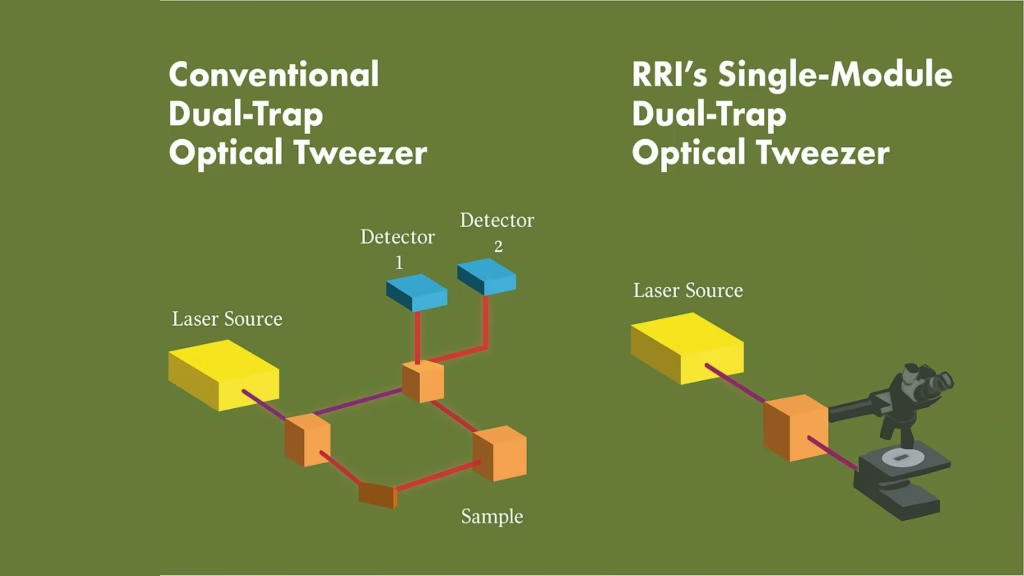
The new system pioneers a confocal detection scheme. In a media statement, Md Arsalan Ashraf, a doctoral scholar at RRI, explained, “The unique optical trapping scheme utilizes laser light scattered back by the sample for detecting trapped particle position. This technique pushes past some of the long-standing constraints of dual-trap configurations and removes signal interference. The single-module design integrates effortlessly with standard microscopy frameworks,” he said.
The refinement doesn’t end there. The system ensures that detectors tracking tiny particles remain perfectly aligned, even when the optical traps themselves move. The result: two stable, reliable measurement channels, zero interference, and no need for complicated re-adjustment mid-experiment—a frequent headache with older systems.
Traditional dual-trap designs have required costly and complex add-ons, sometimes even hijacking the features of laboratory microscopes and making additional techniques, such as phase contrast or fluorescence imaging, hard to use. “This new single-module trapping and detection design makes high-precision force measurement studies of single molecules, probing of soft materials including biological samples, and micromanipulation of biological samples like cells much more convenient and cost-effective,” said Pramod A Pullarkat, lead principal investigator at RRI, in a statement.
By removing cross-talk and offering robust stability—whether traps are close together, displaced, or the environment changes—the RRI team’s approach is not only easier to use but far more adaptable. Its plug-and-play module fits onto standard microscopes without overhauling their basic structure.
From the intellectual property point of view, this design may be a game-changer. By cracking the persistent problem of signal interference with minimalist engineering, the new setup enhances measurement precision and reliability—essential advantages for researchers performing delicate biophysical experiments on everything from molecular motors to living cells.
With the essential building blocks in place, the RRI team is now exploring commercial avenues to produce and distribute their single-module, dual-trap optical tweezer system as an affordable add-on for existing microscopes. The innovation stands to put advanced single-molecule force spectroscopy, long limited to wealthier labs abroad, into the hands of scientists across India—and perhaps spark breakthroughs across the biomedical sciences.
-

 Space & Physics5 months ago
Space & Physics5 months agoIs Time Travel Possible? Exploring the Science Behind the Concept
-

 Know The Scientist5 months ago
Know The Scientist5 months agoNarlikar – the rare Indian scientist who penned short stories
-

 Society4 months ago
Society4 months agoShukla is now India’s first astronaut in decades to visit outer space
-

 Earth5 months ago
Earth5 months agoWorld Environment Day 2025: “Beating plastic pollution”
-

 Society5 months ago
Society5 months agoAxiom-4 will see an Indian astronaut depart for outer space after 41 years
-

 Society6 months ago
Society6 months agoRabies, Bites, and Policy Gaps: One Woman’s Humane Fight for Kerala’s Stray Dogs
-

 The Sciences4 months ago
The Sciences4 months agoHow a Human-Inspired Algorithm Is Revolutionizing Machine Repair Models in the Wake of Global Disruptions
-

 Space & Physics3 months ago
Space & Physics3 months agoJoint NASA-ISRO radar satellite is the most powerful built to date




















